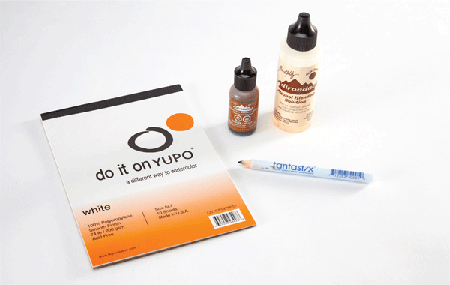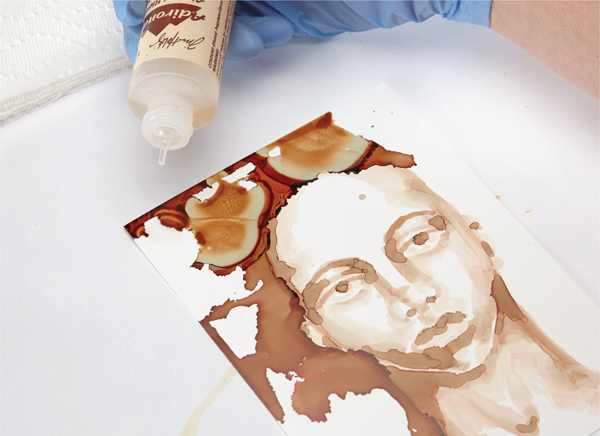

I have to admit I was reluctant to try Yupo paper initially. As a former scrapbooker, the thought of creating something that was not archival was a bit outside my comfort zone. But by using alcohol inks rather than watercolor, you get all the fun play and create a piece of work that is more stable and won’t just wash off. By using just one color of ink, you can also see the array of colors within the ink as the alcohol blending solution pulls it apart on the paper.
white Yupo paper, 7" × 5" (18cm × 13cm)
sepia (or color of your choice)
no. 6 round
alcohol blending solution or rubbing alcohol, dish soap, Fantastix tools (2), lightbox (optional), painter’s tape, paper towels, rubber gloves, small plastic palette with wells

Dirt and oil from your hands may hinder the performance of the Yupo paper, so wash it with mild dish soap and water before using it. Let dry.
Place a sheet of Yupo over one of your sketches on a lightbox, and tape it down with painter’s tape. You may be able to see through the Yupo enough that you don’t need a lightbox.
Yupo is 100 percent recyclable synthetic paper with a nonabsorbent, ultrasmooth surface that allows paints such as watercolors and acrylics to sit on top of the paper. The nonabsorbent nature of Yupo also means it will not buckle, no matter how much water you put on it, and it makes colors more vibrant and brilliant than on standard papers because all of the color sits on the surface.


Use gloves for this step. Squeeze a few drops of sepia (or a color of your choice) alcohol ink into a well on your palette. Then, using a Fantastix tool, pick up some of the ink. The Fantastix will absorb the ink, allowing you to paint with it continuously. Establish the midtones of the face around the outer edge of the face, around the eye area, under the nose and underneath the lower lip.

Put a few drops of the alcohol blending solution or rubbing alcohol onto your palette in a separate well, and dip a clean Fantastix into it. Then use the tool to blend out lighter skin tones from the midtones established in Step 2. The alcohol breaks down the color, separating different hues.

Pick up more alcohol ink on a no. 6 round and begin to drop in the darker areas on the face, including shading on the outer edge of the face, the pupils of the eyes, the inside corners of the eyes, the upper lip, underneath the lower lip, underneath the chin on the neck and any other dark dark areas. The ink will bloom on the paper a bit, so use small amounts and let it organically fill in the shadowed areas of the face. It’s not completely controllable, but that is part of the fun of this project.

Remove the painting from the lightbox and start to create the hair. Use the tip of the ink bottle to apply a bead of ink to the hairline on one side of the head while standing the paper over a stack of paper towels. Make sure the ink is dripping away from the face. Let the ink drip and move organically, making magic on the Yupo paper. Shift and let it drip out from the top of the head too. Add some drops of rubbing alcohol or the blending solution to the hair, and let it interrupt the ink to create light and dark areas. Continue manipulating the ink with the Fantastix tool or a no. 6 round as needed.
It’s exciting to see alcohol inks in action on Yupo. To see this for yourself, you can view a video of this project and learn more about the uncontrolled nature of this medium and how to fix mistakes if things get a little too wild! To watch the video, go to CreateMixedMedia.com/Mixed-Media-Portraits.